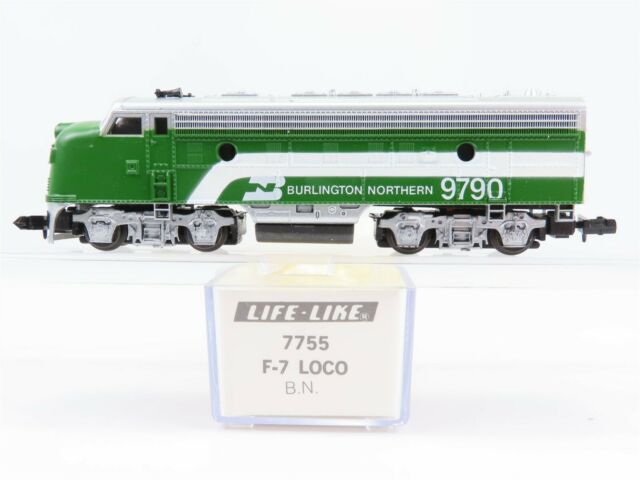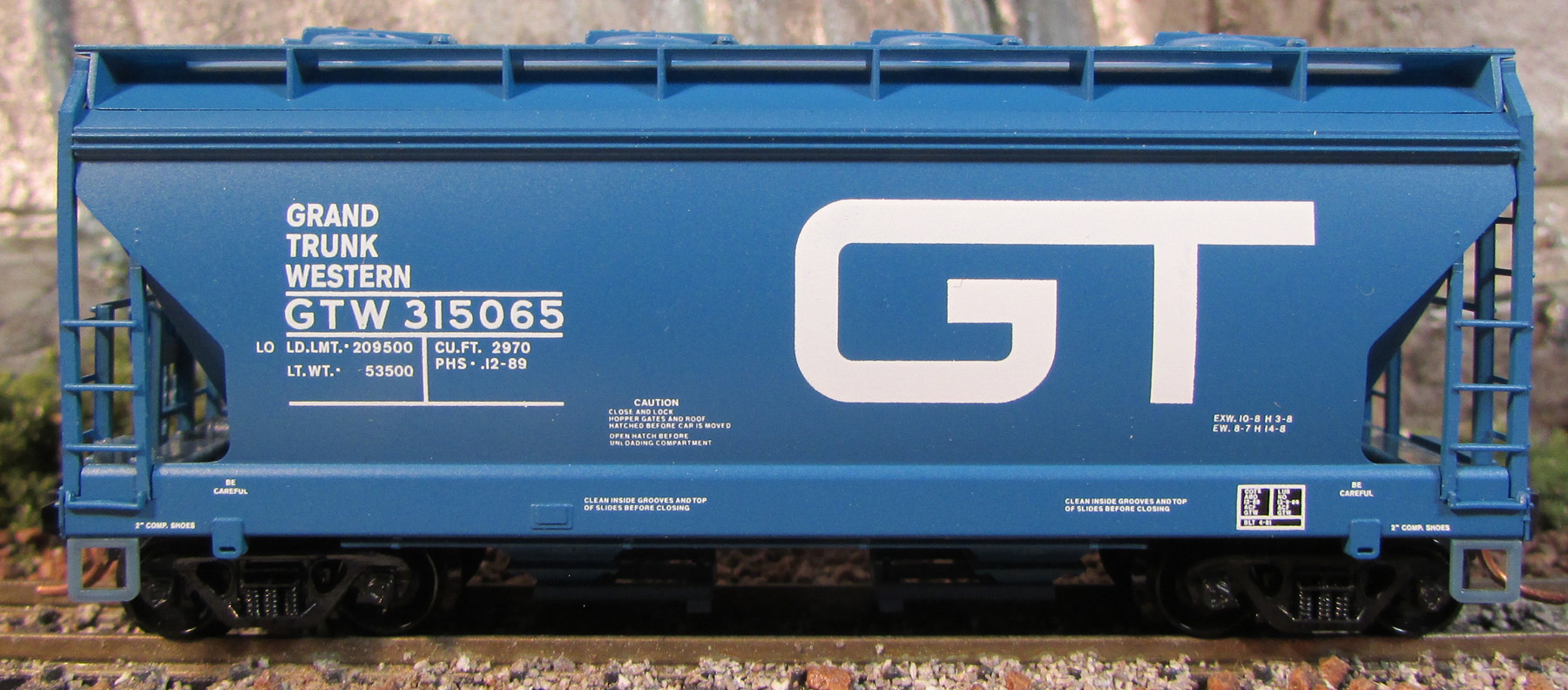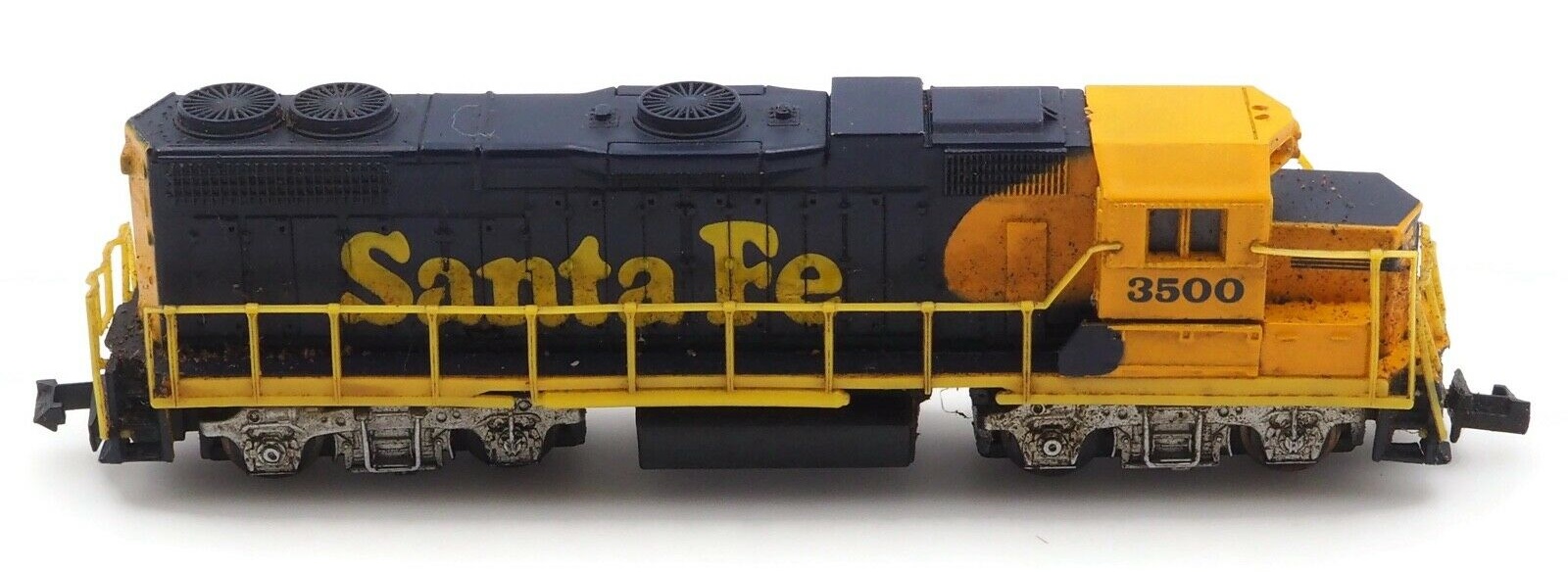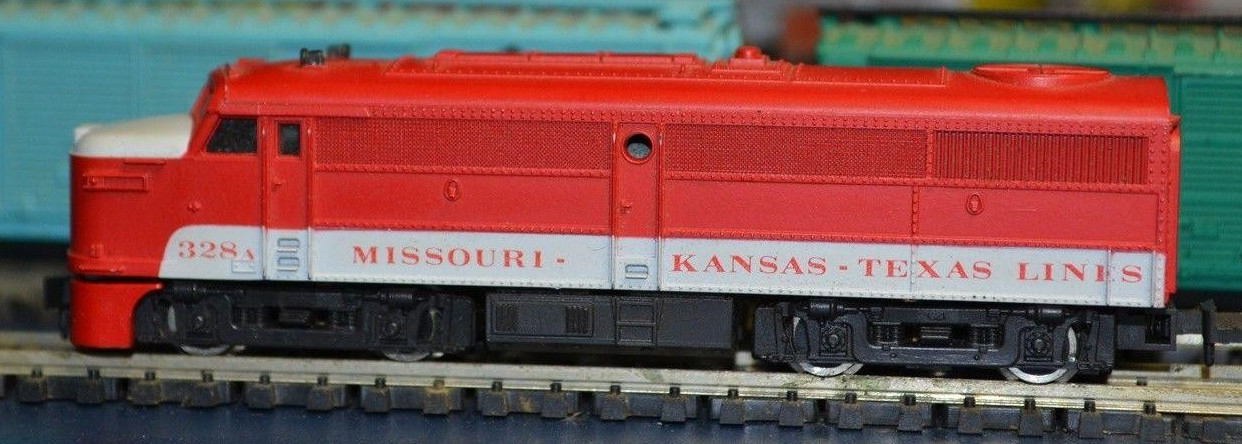Model Information: The Atlas B23-7 was first released in October of 2000. It shares a mechanism with the B30-7 which was released the following year (2001). The B36-7 also shares the same mechanism. The shells of the B23-7 and B30-7 are very very similar and only differ in some minor details. This is a "modern" mechanism with a split-frame, all-metal chassis, 5-pole / skew-wound motor with dual flywheels, low-friction drive, bi-directional LED lighting, all-wheel drive and pickup (no traction tires), blackened / low-profile wheels, shell-mounted Accumate couplers, and all-plastic gearing.
Starting with the 2005 production run, these models were upgraded to include "scale speed" motors and golden-white lighting.
Features:
Fat or thin anticlimber, knuckle or button battery boxes, FB-2, AAR or Blomberg trucks, low or high nose, flat or protruding headlight, 2 or 4 window cab.
Starting with the 2005 production run, these models were upgraded to include "scale speed" motors and golden-white lighting.
Features:
- Directional lighting
- Painted safety rails
- Blackened metal wheels
- Cab sunshades
- Dual flywheel equipped 5-pole skewed armature motor with a low friction mechanism
Fat or thin anticlimber, knuckle or button battery boxes, FB-2, AAR or Blomberg trucks, low or high nose, flat or protruding headlight, 2 or 4 window cab.
DCC Information: Offered in two variations:
One with a factory-installed Lenz decoder and the other with a PC board designed for easy conversion to DCC.
One with a factory-installed Lenz decoder and the other with a PC board designed for easy conversion to DCC.
Prototype History: The GE B23-7 is a diesel locomotive model that was first offered by GE in late 1977. Featuring a smaller 12 cylinder version of the FDL engine, it is the successor to GE's U23B produced from early 1968 to mid 1977, but at 62 ft 2 in (18.95 m) long is exactly 2 ft 0 in (0.61 m). longer. It competed with the very successful EMD GP38-2. General Electric also produced a variant, the BQ23-7, no.5130-5139, for the Seaboard Coast Line. A total of 537 B23-7's were built for 9 U.S. customers and 2 Mexican customers.
A B23-7A is a 12-cylinder B23-7 with horsepower boosted to 250 per cylinder or 3,000 horsepower. In 1980 the Missouri Pacific ordered three B23-7A's (#'s 4667-4669, later UP #'s 257-259) and tested them system-wide. The result was the GE model B30-7A, B30-7 with a 12-cylinder FDL prime mover. They were not renumbered into the B30-7A series on the MP because they lacked Sentry Wheel Slip and had different engine governors.
13 B23-7's were built by GE of Brazil in Dec.1979 for United South Eastern Railways(FUS) no.522-524 and National Railways of Mexico(NdeM) no.9130-9139. 17 B23-7s were built from GE kits in Mexico as Ferrocarriles Nacionales de México no.10047-10052 and no.12001-12011.
From Wikipedia
Read more on American-Rails.com.
A B23-7A is a 12-cylinder B23-7 with horsepower boosted to 250 per cylinder or 3,000 horsepower. In 1980 the Missouri Pacific ordered three B23-7A's (#'s 4667-4669, later UP #'s 257-259) and tested them system-wide. The result was the GE model B30-7A, B30-7 with a 12-cylinder FDL prime mover. They were not renumbered into the B30-7A series on the MP because they lacked Sentry Wheel Slip and had different engine governors.
13 B23-7's were built by GE of Brazil in Dec.1979 for United South Eastern Railways(FUS) no.522-524 and National Railways of Mexico(NdeM) no.9130-9139. 17 B23-7s were built from GE kits in Mexico as Ferrocarriles Nacionales de México no.10047-10052 and no.12001-12011.
From Wikipedia
Read more on American-Rails.com.
Road Name History:  The Southern Pacific Transportation Company (reporting mark SP), earlier Southern Pacific Railroad and Southern Pacific Company, and usually called the Southern Pacific or (from the railroad's initials) Espee, was an American Class I railroad. It was absorbed in 1988 by the company that controlled the Denver and Rio Grande Western Railroad and eight years later became part of the Union Pacific Railroad.
The Southern Pacific Transportation Company (reporting mark SP), earlier Southern Pacific Railroad and Southern Pacific Company, and usually called the Southern Pacific or (from the railroad's initials) Espee, was an American Class I railroad. It was absorbed in 1988 by the company that controlled the Denver and Rio Grande Western Railroad and eight years later became part of the Union Pacific Railroad.
The railroad was founded as a land holding company in 1865, later acquiring the Central Pacific Railroad by lease. By 1900 the Southern Pacific Company was a major railroad system incorporating many smaller companies, such as the Texas and New Orleans Railroad and Morgan's Louisiana and Texas Railroad. It extended from New Orleans through Texas to El Paso, across New Mexico and through Tucson, to Los Angeles, through most of California, including San Francisco and Sacramento. Central Pacific lines extended east across Nevada to Ogden, Utah, and reached north through Oregon to Portland. Other subsidiaries eventually included the St. Louis Southwestern Railway (Cotton Belt), the Northwestern Pacific Railroad at 328 miles (528 km), the 1,331 miles (2,142 km) Southern Pacific Railroad of Mexico, and a variety of 3 ft (914 mm) narrow gauge routes.
In 1929 SP/T&NO operated 13848 route-miles not including Cotton Belt, whose purchase of the Golden State Route circa 1980 nearly doubled its size to 3,085 miles (4,965 km), bringing total SP/SSW mileage to around 13,508 miles (21,739 km).
By the 1980s route mileage had dropped to 10,423 miles (16,774 km), mainly due to the pruning of branch lines. In 1988 the Southern Pacific was taken over by D&RGW parent Rio Grande Industries. The combined railroad kept the Southern Pacific name due to its brand recognition in the railroad industry and with customers of both constituent railroads. Along with the addition of the SPCSL Corporation route from Chicago to St. Louis, the total length of the D&RGW/SP/SSW system was 15,959 miles (25,684 km).
By 1996 years of financial problems had dropped SP's mileage to 13,715 miles (22,072 km), and it was taken over by the Union Pacific Railroad.
Read more on Wikipedia.

The railroad was founded as a land holding company in 1865, later acquiring the Central Pacific Railroad by lease. By 1900 the Southern Pacific Company was a major railroad system incorporating many smaller companies, such as the Texas and New Orleans Railroad and Morgan's Louisiana and Texas Railroad. It extended from New Orleans through Texas to El Paso, across New Mexico and through Tucson, to Los Angeles, through most of California, including San Francisco and Sacramento. Central Pacific lines extended east across Nevada to Ogden, Utah, and reached north through Oregon to Portland. Other subsidiaries eventually included the St. Louis Southwestern Railway (Cotton Belt), the Northwestern Pacific Railroad at 328 miles (528 km), the 1,331 miles (2,142 km) Southern Pacific Railroad of Mexico, and a variety of 3 ft (914 mm) narrow gauge routes.
In 1929 SP/T&NO operated 13848 route-miles not including Cotton Belt, whose purchase of the Golden State Route circa 1980 nearly doubled its size to 3,085 miles (4,965 km), bringing total SP/SSW mileage to around 13,508 miles (21,739 km).
By the 1980s route mileage had dropped to 10,423 miles (16,774 km), mainly due to the pruning of branch lines. In 1988 the Southern Pacific was taken over by D&RGW parent Rio Grande Industries. The combined railroad kept the Southern Pacific name due to its brand recognition in the railroad industry and with customers of both constituent railroads. Along with the addition of the SPCSL Corporation route from Chicago to St. Louis, the total length of the D&RGW/SP/SSW system was 15,959 miles (25,684 km).
By 1996 years of financial problems had dropped SP's mileage to 13,715 miles (22,072 km), and it was taken over by the Union Pacific Railroad.
Read more on Wikipedia.
Brand/Importer Information: In 1924 Stephan Schaffan, Sr. founded the Atlas Tool Company in Newark, New Jersey. In 1933 his son, Stephan Schaffan, Jr., came to work for his father at the age of sixteen. Steve Jr. built model airplanes as a hobby and frequented a local hobby shop. Being an enterprising young man, he would often ask the owner if there was anything he could do to earn some extra spending money. Tired of listening to his requests, the hobby-store owner threw some model railroad track parts his way and said, "Here, see if you can improve on this".
In those days, railroad modelers had to assemble and build everything from scratch. Steve Jr. created a "switch kit" which sold so well, that the entire family worked on them in the basement at night, while doing business as usual in the machine shop during the day.
Subsequently, Steve Jr. engineered the stapling of rail to fiber track, along with inventing the first practical rail joiner and pre-assembled turnouts and flexible track. All of these products, and more, helped to popularize model railroading and assisted in the creation of a mass-market hobby. The budding entrepreneur quickly outgrew the limitations of a basement and small garage operation. Realizing they could actually make a living selling track and related products, Steve and his father had the first factory built in Hillside, New Jersey at 413 Florence Avenue in 1947. On September 30, 1949, the Atlas Tool Company was officially incorporated as a New Jersey company.
In 1985, Steve was honored posthumously for his inventions by the Model Railroad Industry Association and was inducted into the Model Railroad Industry Hall of Fame in Baltimore, Maryland. In addition, Steve was nominated and entered into the National Model Railroad Association Pioneers of Model Railroading in 1995.
In the early 1990s, the Atlas Tool Company changed its name to Atlas Model Railroad Company, Inc.
In those days, railroad modelers had to assemble and build everything from scratch. Steve Jr. created a "switch kit" which sold so well, that the entire family worked on them in the basement at night, while doing business as usual in the machine shop during the day.
Subsequently, Steve Jr. engineered the stapling of rail to fiber track, along with inventing the first practical rail joiner and pre-assembled turnouts and flexible track. All of these products, and more, helped to popularize model railroading and assisted in the creation of a mass-market hobby. The budding entrepreneur quickly outgrew the limitations of a basement and small garage operation. Realizing they could actually make a living selling track and related products, Steve and his father had the first factory built in Hillside, New Jersey at 413 Florence Avenue in 1947. On September 30, 1949, the Atlas Tool Company was officially incorporated as a New Jersey company.
In 1985, Steve was honored posthumously for his inventions by the Model Railroad Industry Association and was inducted into the Model Railroad Industry Hall of Fame in Baltimore, Maryland. In addition, Steve was nominated and entered into the National Model Railroad Association Pioneers of Model Railroading in 1995.
In the early 1990s, the Atlas Tool Company changed its name to Atlas Model Railroad Company, Inc.
Item created by: Alain LM on 2016-10-11 06:43:45
If you see errors or missing data in this entry, please feel free to log in and edit it. Anyone with a Gmail account can log in instantly.
If you see errors or missing data in this entry, please feel free to log in and edit it. Anyone with a Gmail account can log in instantly.










